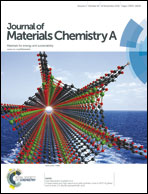A water-based and high space-time yield synthetic route to MOF Ni2(dhtp) and its linker 2,5-dihydroxyterephthalic acid†
Abstract
2,5-Dihydroxyterephthalic acid (H4dhtp) was synthesized on an 18 g scale by carboxylation of hydroquinone in molten potassium formate. The hydrated form of the Ni2(dhtp) MOF (also known as CPO-27-Ni and MOF-74(Ni)) was obtained in 92% yield by refluxing for 1 h a water suspension of the H4dhtp linker with an aqueous solution of nickel acetate. The ensuing characterization of the material (XRD, HRTEM, TGA, N2 adsorption at 77 K – SBET = 1233 m2 g−1) confirmed the formation of a metal–organic framework of at least equal quality to the ones obtained from the previously reported routes (CPO-27-Ni and MOF-74(Ni)), with a different morphology (namely, well-separated 1 μm platelets for the herein reported water-based route). The temperature dependence of the magnetic susceptibility was measured and satisfactorily simulated assuming a Heisenberg (H = −2JΣSiSi+1) ferromagnetic intrachain interaction (J = +8.1 cm−1) and an antiferromagnetic interchain interaction (J′ = −1.15 cm−1). Overall, the reaction in water appears to follow easily distinguishable steps, the first being the deprotonation of H4dhtp by an acetate counterion, leading to a soluble nickel adduct of the linker, en route to the MOF self-assembly.

- This article is part of the themed collection: 2014 Journal of Materials Chemistry A Hot Articles

 Please wait while we load your content...
Please wait while we load your content...